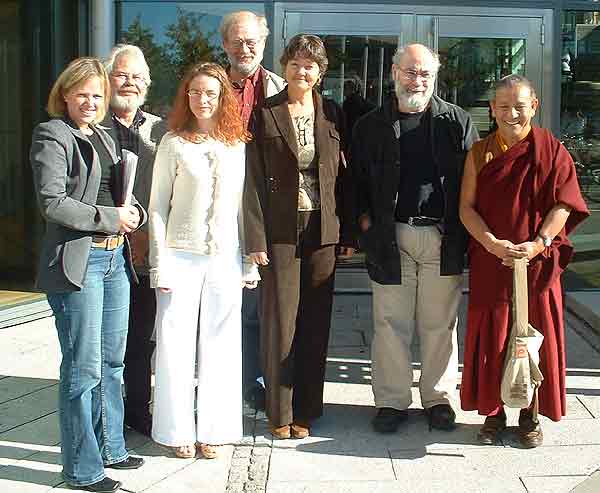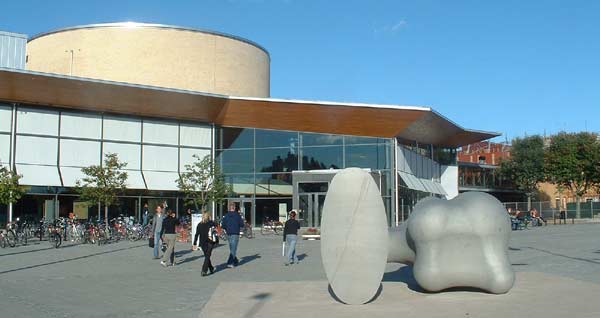SWEDISH SOUTH ASIAN STUDIES NETWORK
|
|
Report from the SASNET seminar at Karlstad University, Wednesday 24 September 2003:
Follow-up meeting to the SASNET
symposium
for PhD candidates
held
in Marstrand in October 2002.
Participants from Karlstad University: |
|||
| Per-Olof Fjällsby | Kjell Härenstam | Marc Katz | Gerhard Gustafsson |
| Eeva Lakomaa | Inga-Lill Fjällsby | Ann-Britt Höglund | Malin Holmgren |
| Lina Bernäng | Helén Blomquist | Jan Rodin | Albrecht Jung |
| Lotta Leander | Annelie Olsson | Viveka Johansson | Peter Olsson |
| Johan Viking | Erik Andersson | Linda Larsson | Madeleine Augustsson |
| Maja-Karin Ekåsen | Kristofer Andersson | Sara Westlindh | Andreas Hofer |
| Elisabet Härenstam | Peema Dorje | ||
From SASNET, Lund University:
Staffan Lindberg and Lars
Eklund
 |
| Some of the participants at the SASNET seminar at Karlstad University: Malin Holmgren, former student at the Dept. of Religion; Staffan Lindberg, SASNET; Helen Blomkvist, Dept. of Political Science; Per-Olof Fjällsby, Dept of History; Inga-Lill Fjällsby, Teachers training department; Marc Katz, Dept of Religion; and Peema Dorje, College for Higher Tibetan Studies, Dharamsala, India. |
The purpose of holding a South Asia day was to inform about the research. education and exchange programmes that are carried out at Karlstad university in connection with South Asia; and to discuss how SASNET and Karlstad University should be able to develop a closer collaboration.
9.00–10.00 Brief History of Karlstad University’s
activities in South Asia:
Per-Olof Fjällsby, Dept
of History, made an introduction, before leaving the floor to Staffan
Lindberg, who emphasized SASNET’s willingness to
promote KU’s South Asia oriented activities and the opportunities
that SASNET can offer.
Inga-Lill Fjällsby,
from the Office for Educational and Research Planning, then presented
the history of KU in India during the last 20 years, focussing on the
major role that Ganga Mahal, the Swedish Study Centre in Varanasi, has
played. See SASNET’s page on Karlstad University
activities in and with South Asia!
Compare also with details described in the report
from the SASNET meeting at Karlstad University in December 2000!
After the presentation Staffan Lindberg enquired about
the possibilities for other Swedish universities than those already involved
to use the facilities of the study centre at Varanasi, and got an affirmative
response from Inga-Lill Fjällsby.
P-O Fjällsby however added that there is a problem in that the university
does not pay anybody to administer the South Asia activities. It is therefore
based on voluntary work by a few individuals. Furthermore there is an
economic uncertainty in that the Swedish Study Centre at Varanasi is financed
by the students fees only.
10.00-11.15 Experiences from Working with Film
as an Academic Tool.
Associate Professor Marc Katz, Dept of Religion,
came to the seminar along with a number of students. Katz has specialized
on working with documentary films as a tool for research on Indian religion.
More information on Marc Katz film projects
since 1994.
He is presently working with his third film, focussing on Muharram,
the Shia Moslem festival which in Varanasi is a multicultural event being
celebrated by members of all communities. The film, parts of which now
were shown, is based on fieldwork carried out in 2002 and reflects, according
to Katz, the all-inclusive traditions that are so strong in Varanasi.
Katz complained that working with documentary film is not an established
research method in Sweden. Unlike in some other countries it does not
give any academic merits in Sweden, and no film archives are available.
He argued for the many benefits that documentary films have, especially
the possibility to analyze and reinterpret the material several times
as you are able to view things from different angles. Often interesting
informations can be discovered at a later stage among material you have
first overlooked. Marc Katz mentioned his film ”Holi Hey”
which he made 10 years ago, and where he has made such discoveries much
later.
A discussion on the topic followed, in which Staffan Lindberg, SASNET,
suggested that a seminar should be arranged on ”Film as a research
method”, and he also urged Marc Katz to formulate his theoretical
framework in writing. This idea was also supported by P-O Fjällsby.
10.45-11.15 Mutual Stereotypes in Textbooks
Associate Professor Kjell Härenstam, also from the Dept
of Religion, has been involved in text book studies since the early
1990’s. He studied the images of Islam given in Swedish text books,
and published a book ”Perspektiv på Islam-bilden”,
and he took also part in an International German-led project on the same
issue. Later on he travelled to India, visited the Buddhist pilgrimage
place Sarnath, and by chance he also visited Dharamsala with a group of
Karlstad University teachers training students.
He then changed his research focus to study Tibetan Buddhism, and how
this religion has been portayed in Swedish text books. An interesting
observation he made was that the image has reflected the political development.
In the 1970’s the image was characterized by Chinese propaganda
and was very negative – the image of a degenerated variety of Buddhism,
but after the Tiananmen massacre, and the Nobel Peace Prize awarded to
Dalai lama, Tibetan Buddhism is now positively described in Swedish text
books, as an ancient philosophy well adapted to modern times.
Kjell Härenstam then informed about his new research project, dealing
with mutual stereotypes in school text books in India (the states of Himachal
Pradesh and Uttar Pradesh), and in Sweden. He has decided to specially
study how the concepts of ”Nationalism” and ”Equality”
are dealt with, and also how these concepts have undergone changes over
time within the two countries. Furthermore he is going to examine the
ongoing higly controversial revision of Indian text books, initiated by
the BJP dominated government.
11.15-12.00 Children’s books project for Swedish
and Tibetan Children
Elisabet Härenstam, Dept of History of Literature, visited Dharamsala
for the first time in 1995, and she became fascinated by the Tibetan refugee
community, and its strong ambitions to keep the traditional culture in
exile. As Elisabet is also an avid storyteller she started to search for
some good Tibetan storytellers. She was recommended by Dalai lama to meet
Peema Dorje, headmaster at Tibetan Children’s Village, and that
meeting turned out to be very fruitful. It resulted in a book called ”Det
var en gång en sjö” jointly published by Karlstad
University and a Tibetan publisher in India. The book, consisting of Peema
Dorje’s childhood memories, was beautifully illustrated by a Tibetan
thanka painter, and had an introduction by Dalai lama.
The two have since continued to work together, and Peema Dorje, now in
charge of the teachers training at the College for Higher Tibetan Studies
at Dharamsala – established in 1996 and an institute with which
Karlstad University has a collaboration agreement – has visited
Karlstad every year since 1998. In the same way as with the first book
they have now produced another one, called ”En enda rödklädd
unge”, which they were going to present at the 19th Göteborg
International Book Fair 25–28 September 2003.
Elisabet Härenstam presented their books project and a slide show
produced by media students at a Karlstad high school. Peema Dorje then
presented himself. With a monastic educational background he is now much
engaged in modern Ecology and Psychology – ”which have much
to learn from Buddhism” – and is responsible for the upkeep
of 84 Tibetan schools in India, 15 in Nepal, and 5 in Bhutan.
13.00- 13.30 What can a network like SASNET offer?
Lars Eklund, SASNET, made an extensive presentation of the SASNET web
site, and the possibilities it offers for researchers, teachers and students
at Karlstad University.
13.30-14.00 To prepare and guide students doing
fieldwork in India
Professor Gerhard Gustafsson, and three former C-level students (Kristofer
Andersson, Sara Westlindh and Andreas Hofer), from the Dept
of Geography and Tourism presented their department‘s long-standing
India connection. Contacts were established through Prof Rana P B Singh,
Dept of Geography, Banaras Hindu University (BHU), Varanasi, India, who
visited Karlstad first time in 1989. Geography students from Karlstad
have from the beginning of the 1990’s regularly gone to Varanasi
to do fieldwork, and one student has even carried on and eventuelly completed
her doctoral dissertation on the study of a village outside Varanasi.
More information on Kristina (Nina) Lejonhud’s
dissertation in June 2003.
Karlstad University has been able to secure funds from the Linnaeus Palme
Programme for teachers and students exchange with BHU, and the department
has in the last few years held seminar series in Varanasi for its students,
along with other Karlstad students from the Dept of Religion.
Gerhard Gustafsson described the problems that students face while carrying
out field work in India, and the main problem is the language barrier.
For studies on tourism (which have been popular) and studies carried out
in the cities it may do with English, but to do village studies with no
command of the local language is very problematic. Besides certain issues,
like women’s studies or politics, might be sensitive in an Indian
context. In spite of such hurdles Gustafsson was pleased to tell about
the field work studies being produced, especially those comparing different
cultures and eventually finding similarities between the development in
India and Sweden.
The three former students then told about their personal experience from
doing fieldwork in Varanasi last year as part of a group staying at Ganga
Mahal. They complained that they had no Swedish supervisor with them,
and that was a negative factor negatively affecting the scientific level
on the field reports. Regarding their accommodation at the Swedish Study
Centre it also turned out to be a mixed blessing to live together with
only other Swedes. However wonderful to have access to a library, a well-connected
local supervisor, Omji, and interpreter service, on the other hand it
created a form of isolation from the surrounding Indian society.
It might end up that all the Swedes just sit in their cosy study centre,
seeing only each other or acquainting backpacker tourists. When the group
is rather big it easily happens that contact making with local people
does not become a priority.
A couple of the Swedish geography students could not be accommodated at
Ganga Mahal but had to stay at an International guest house called Amar
Bhawan. They reported much more useful International contacts established
there, e g with American PhD students from the University of Wisconsin,
Madison, who had a thorough knowledge on India.
Staffan Lindberg, SASNET, intervened by describing the somewhat different method followed by Österlen folk high school in Tomelilla, who sends students on its undergraduate social science course on India/South Asia (see information). Their students after an initial joint week in South India then divide in smaller groups and do field work in many different places.
Kristofer Andersson, Sara Westlindh and Andreas Hofer rounded
up by listing their main points of critique against their field work
in Varanasi:
• They should also have visited villages and not just stayed inside
the city.
• Too much research and studies have been focussed on Varanasi,
and in particular the Assi Ghat area near to the Swedish Study Centre.
• The field work reports should be written in English. Now they
are mostly written only in Swedish which makes their impact negligible.
Besides it does not create any response back to the local people interviewed/reported
upon.
14.00-15.00 Discussion on how to continue cooperation for South
Asian studies
As the programme for the day had run over time considerably the final
discussion on how to continue cooperation for South Asian studies did
not materialize as a separate point. All participants were however happy
with the outcome of the day, and SASNET offered its assistance in improving
the aspect of information regarding South Asia related activities at Karlstad
University in the future.
SASNET - Swedish South Asian Studies Network/Lund
University
Address: Scheelevägen 15 D, SE-223 70 Lund, Sweden
Phone: +46 46 222 73 40
Webmaster: Lars Eklund
Last updated
2010-03-01

